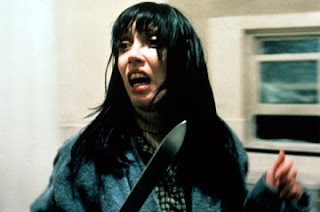In class we've looked at four different Narrative Theorists, and tested them out by applying their ideas to 'The Shining'.
Propp.
Propp looked at 100's of Folk Tales and identified 8 character roles:
1 - The Villain.
2 - The Hero.
3 - The Donor.
4 - The Helper.
5 - The Princess.
6 - Her Father.
7 - The Dispatcher.
8 - The False Hero.
We discovered that some of these character types fit into the 'The Shining'. For example:
The Donor/Helper - Dick Halloran.
Halloran can be seen as the 'Donor' character in the movie as he helps Danny discover that he has the gift of 'The Shining', and towards the end of the movie (even though Halloran loses his life) the Snowcat he travelled to the hotel in, is later used as Wendy and Danny's escape vehicle.
The Hero - Wendy and Danny.
Wendy and Danny fight back against Jack. Danny leads him into the maze and tricks Jack by brushing away his snowy footprints, and escaping. Jack dies in the maze, which means that we can see Danny as the hero for defeating him, and Wendy for fighting back throughout.
The Princess - Wendy.
The Princess is generally seen as a 'prize' to The Hero, and as Danny gets out of the maze, Wendy is there to escape with him.
The Villain - Jack/The Hotel.
Jack is seen as the main Villain in the movie, as he goes insane and tries to kill his family. However, we can also personify the Hotel as a Villain, because if it wasn't for all the 'supernatural' activity during their stay, then maybe nothing would've happened.
Other ideas of Propp's also fit the plot of the movie. For example:
Propp's theory is that, at the beginning of a story, a 'prohibition' or 'rule' is set up, which is then broken. In 'The Shining', the rule is - "Do not go in Room 237" - which is of course, broken, as Danny and Jack enter the room.
A problem with Propp's theory is that, his list of 31 Narrative Functions work, until we reach these points -
20 - RETURN: Hero returns;
21 - PURSUIT: Hero is pursued (pursuer tries to kill, eat, undermine the hero);
22 - RESCUE: Hero is rescued from pursuit (obstacles delay pursuer, hero hides or is hidden, hero transforms unrecognisably, hero saved from attempt on his/her life);
23 - UNRECOGNIZED ARRIVAL: Hero unrecognized, arrives home or in another country;
24 - UNFOUNDED CLAIMS: False hero presents unfounded claims;
25 - DIFFICULT TASK: Difficult task proposed to the hero (trial by ordeal, riddles, test of strength/endurance, other tasks);
26 - SOLUTION: Task is resolved;
27 - RECOGNITION: Hero is recognized (by mark, brand, or thing given to him/her);
28 - EXPOSURE: False hero or villain is exposed;
29 - TRANSFIGURATION: Hero is given a new appearance (is made whole, handsome, new garments etc.);
30 - PUNISHMENT: Villain is punished;
31 - WEDDING: Hero marries and ascends the throne (is rewarded/promoted).
Propp's list of Narrative Structure fits the movie well, up until these points, because once we've applied the list to 'The Shining', Jack is already dead before these ones can be applied. However, you could say that number 31 applies as the movie technically ends in a Funeral.



This is very good and thorough on Propp, Hannah. What about our other theorists - Todorov, Levi-Strauss, Bordwell and Thompson? Please add them or add new posts about them.
ReplyDelete